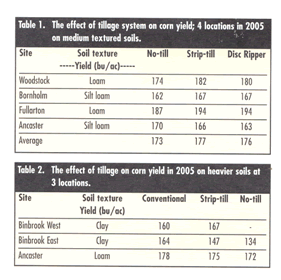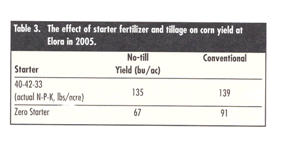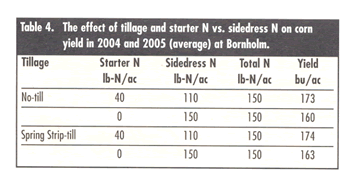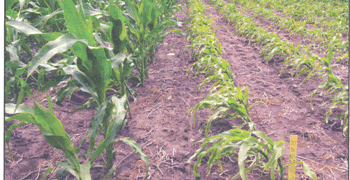
In a year where conditions were dry but yields were high, did we learn anything new from cropping system comparisons?
| Deep Tillage In assessing the conditions and results from 2005, it is clear that although crops were under moisture stress frequently, root growth and function must have been excellent for much of the corn crop across the province. On tillage plots where we imposed some aggressive tillage (disc ripper with the shanks operating at 12" deep), it did not appear to improve upon these conditions nor generate any additional yield. Table 1 summarizes those plots where we had a range of tillage intensities. I still question how you pay for the deep tillage in most conditions, not just in a high yield year, but most of the time. |
Figure 1. Planting on fall made strips in soybean ground in Ancaster. In these conditions strips can be, on occasion tough to see. Windshield needs to be clean! |
 |
Tillage on Heavier Soils Of course our producer friends on heavier soils continue to question the movement towards less tillage. Ian McDonald, OMAFRA, has been leading the charge on this project to investigate this problem on the heavier soils of the Niagara area. Table 2 would illustrate that some of the concerns on heavier ground are justified. The Binbrook East site showed we are making some progress with strip tillage compared to no-till but there is still some work to be done. The fall strip tillage on this site needs to be done under better (drier conditions) than it was done in the fall of 2004 if we are going to close the gap on conventional tillage. At the other two sites in Table 5, reduced tillage systems were the most economical approach. |
| Starter Impacts Some of the trials in 2005 re-confirmed lessons that we have been taught a few times. This was the case in terms starter response. In Table 3 the impact of starter fertilizer is shown to be huge, of course this is not too big a surprise, as the soil tests were 8 for P, and 88 for K (see figure 2). The intriguing issue is that with starter applied, the No-till and conventional tillage plots were essentially equal in corn yields. However, take the starter away and the no-till comes up 24 bushels/acre short of the conventional. Now in this case, you obviously would want the starter running in both tillage systems, however it does emphasize the idea that in no-till, it's 24 bushels more critical. N.B. Reducing tillage on low to moderate soil test soils can work, but don't try it without a full rate banded starter fertilizer. |
 |
 |
We have shown data in the past that illustrates the need for adequate N to be applied at planting time if you plan on sidedressing the bulk of your N in June. Table 4 illustrates this concept quite forcefully, as we have registered an 11-14 bushel per acre loss when we put no nitrogen down at planting time and then expect a full rate at sidedress to do the job. |
Unfortunately in some cases, the corn runs out of N before sidedress time and a yield hit is taken that cannot be recovered with even high rates of N during the sidedress operation. I should note that this does not occur all the time. l.thought at one time that it was more of a problem in cool, damp springs where the N supply in the soil is more limited. However, we saw it again at various locations, even in 2005. N.B. 20-40 lbs N/acre at planting is definitely a good policy for those who sidedress nitrogen even in a dry spring.
 |
Figure 2. No-till corn planted May 6 in Elora with (left side) and without (right side) starter fertilizer (40-42-33 actual N-P-K in Ibl ac). Phosphourus and potassium soil levels were 8 and 88 ppm, respectively. |